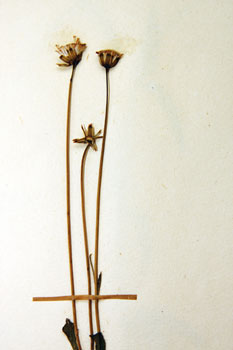 |
Botanical sample. (Bruce Bottomley Photo) |
If there was a museum of museums, Dalhousie’s own Thomas McCulloch Museum would be an ideal candidate for display.
The museum—no doubt you’ve walked by it in the basement of the Life Sciences Centre on the way to Tim Hortons—is quaint and old fashioned, with handwritten labels and the odor of mothballs in the air. But it houses a fascinating, eclectic collection of natural artifacts, ranging from 565-million-old Burgess Shale fossils, delicate botanical samples collected and pressed between absorbent paper and butterflies, beetles and other insects, stuck with pins and displayed in rows.
SEE PHOTO ESSAY: Dr. McCulloch's cabinets
At the heart of the collection are the bird specimens collected by Thomas McCulloch, who was the first president of Dalhousie College back in 1838. The oldest birds date to 1830, when they were caught, captured, stuffed and sealed forever behind glass.
Arranged “Audubon style,” in realistic scenarios as popularized by wildlife portrait artist John James Audubon, the idea was to give an idea of the bird in their natural habitat. And thus, the Raven, iridescent blue-black and bigger than you’d imagine, fixes passersby with a glassy stare; and the eagle family settles in for a meal—the eaglets with mouths open wide for the flicker clasped in dad’s talons.
Bald eagle
This is the display that Steve Fry likes to point out to visitors. Even after 180 years, well, it never really gets old. For one thing, it’s amazing to see how massive the Bald Eagle is, measuring up to a metre in length, from its ferocious-looking white head to its tail feathers. While this cozy domestic tableau has been frozen in time, eagle populations in Nova Scotia have been in flux. Numbers of these birds of prey plummeted in the last century due to the use of pesticides, DDT in particular. But, in recent years, the Bald Eagle has rebounded and is even plentiful in parts of the province. (During the annual Eagle Watch weekend in Sheffield Mills, near Wolfville, more than 80 of the big birds were spotted feeding, in the trees and soaring in the sky.)
“They are just magnificent creatures and you can never see them like this up close,” says Mr. Fry, the museum’s curator. Dr. McCulloch’s collection also had a Labrador Duck specimen, but it was loaned to the Canadian Museum of Nature in Ottawa as the only extant specimen of the species in Canada. Once a regular visitor to Nova Scotia’s coast in the winter, the Labrador Duck was declared extinct in 1878.
Brian Hall, professor emeritus of biology, is eager to point out the three-toed footprint of a dinosaur—either that or a giant bird—preserved in a slab of sedimentary rock. The story goes that the large fossil was discovered by a grad student on a road trip to California and eventually brought back to his alma mater. In the meantime, all context was lost including where exactly it was found and any other fossils that might have been there.
“I imagine it had a thumb stuck in the air which didn’t make an impression,” says Dr. Hall, running a palm along the pale rock.
Victorian sensibility
A leader in the field of evolutionary developmental biology, Dr. Hall says while the museum does seem rather Victorian, that’s because it is. Queen Victoria reigned from 1837 to 1901, presiding over a time when the study of natural science became enormously appealing to all kinds of people. Scientific exhibitions such as Professor McCulloch’s educated and entertained the general public. Many scientists were amateurs, compiling collections and cataloguing them.
As long as science is based on careful observation, the museum will continue to have value, says Dr. Hall. Students can learn about the natural world by making drawings and notes using the long-dead samples, or by choosing something more lively, like one of the clownfish swimming in the aquariums or a starfish, sea urchin or hermit crab from the touch tanks. They also continue to add to the museum’s vast collection of dried botanical samples using the same methods of plant pressing employed by respectable Victorian ladies a century and a half ago.
And, if you don’t mind the antique smell, the museum is a good spot for students looking for a quiet place to study. Classes and discussion groups are also welcome.
“We’re always trying to make the museum as accessible and as welcoming as possible,” says Mr. Fry.
